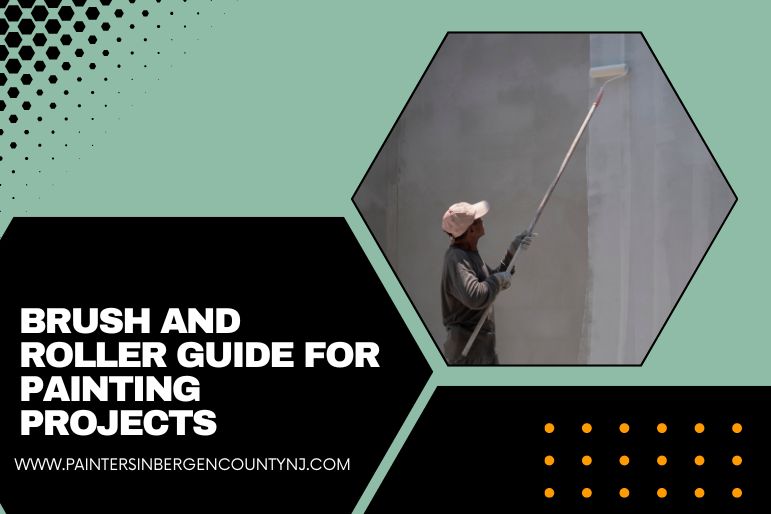When it comes to painting projects, selecting the appropriate tools, such as paint brushes and rollers, can significantly impact the outcome.
Choosing the right roller and roller cover, loading and using them properly, and selecting the appropriate brushes and painting techniques can be overwhelming due to the wide range of options available. This guide covers all you need to know to make informed decisions. By the end of this article, you will feel confident enough to take on any painting project.
Choosing the Right Roller Cover and Roller for Your Project
To get the desired surface finish, it’s important to choose the appropriate roller cover based on the painting task. Synthetic roller covers, made from nylon, polyester, or a combination of both, are suitable for smooth and semi-smooth surfaces. They offer durability and easy cleaning and can be used with both oil-based and latex paints.
Natural fiber roller covers, such as lambswool and mohair, are great for painting textured surfaces. They hold more paint than synthetic covers, allowing for better coverage on rough surfaces. Natural fiber roller covers are best used with oil-based paints.
To choose the right roller cover size, consider the size of the surface you are painting. Roller covers come in lengths from 4 inches to 18 inches. For smaller areas like trim work, choose a 4-6 inch roller cover. Use a 9-18 inch roller cover for larger areas like walls and ceilings.
Choosing the Right Brushes and Painting Techniques
If you need to paint narrow areas like trim or tight corners, consider using a paintbrush. They come in various sizes and materials, similar to roller covers. For painting trim and hard edges, you’ll want an angled sash brush with bristles that are angled to help paint straight lines and access tight corners. For larger areas like walls or ceilings, a flat brush will work well.
For optimal results, it’s recommended to use natural bristle brushes with oil-based paints and synthetic brushes with latex paints. Take note that natural bristle brushes made from animal hair work best for smooth surfaces, while synthetic brushes made from nylon or polyester are more suited for textured surfaces.
To achieve a professional-looking finish, use long, even strokes with your roller, working from the top to the bottom of the surface. Keep a wet edge by painting adjacent sections before the previous section dries. Avoid using too much paint on your roller, which can lead to drips and an uneven finish. Use a brush to fill in the gaps for areas where a roller cannot reach. Use a small brush or an angled sash brush for tight corners and edges.
Loading and Using Your Roller Cover
Once you have chosen the right roller cover and roller for your project, it’s time to load your roller cover. Here are some tips for properly loading your roller:
- Fill your paint tray with paint to a depth of about 1 inch.
- Dip your roller cover into the paint, then roll it back and forth in the paint tray to evenly distribute the paint.
- Use the ridges in the paint tray to remove excess paint from your roller cover.
- Begin painting at the top of the surface and work your way down, using long, even strokes.
- For best results, use a roller with a nap that is compatible with the surface you are painting.
Excess Paint: How to Remove It
Removing excess paint from your roller cover is important to achieve an even and smooth finish. Here are some tips for removing excess paint:
- Use the ridges in your paint tray to remove excess paint from your roller cover.
- Gently press the roller cover against the side of the paint tray to remove excess paint.
- If there is still too much paint on your roller cover, roll it over a piece of cardboard or paper towel to remove even more paint.
Painting Tools and Terms
Paint Roller
A painting tool with a small handle is used for applying paint onto a surface.
Paint Roller Covers
A roller cover is a cylindrical sleeve used to apply different types of paint onto various surfaces. They come in different sizes and materials to fit onto paint rollers.
Paint Surface Vertically
To paint a surface vertically means to apply the paint to an upright surface while starting from the top and working downwards. This method ensures that the paint application is uniform and seamless, resulting in a professional finish. Choose a roller with an appropriate nap for the surface, load it with paint, and use long strokes to achieve the desired coverage.
To maintain a wet edge, it’s best to paint neighboring sections only after the previous one has completely dried. Use a small brush on tight edges or corners to fill in gaps. Scrap off any extra paint from the brush against the ridges in the paint tray before starting to paint.
Synthetic Roller Covers
Synthetic roller covers are made from materials like nylon or polyester and are ideal for use with latex paints. They work better than natural bristle brushes on textured surfaces.
Synthetic roller covers come with the benefit of holding more paint than natural bristle brushes. Consequently, it yields better coverage and an even finish while painting. However, synthetic roller covers have the drawback of leaving lint or fuzz on the surface being painted. Therefore, it is crucial to choose a roller cover with the appropriate nap for your project.
Paint Roller Frame
A paint roller frame is a tool that consists of a handle and two frames which hold a roller cover. It is used to achieve smooth and controlled paint coverage. You have the option to choose between a solid or spring-loaded frame, whereas the latter is more suitable for textured surfaces because of its flexibility. It is recommended to use an extension pole for painting hard-to-reach areas to avoid any physical strain.
Right Roller Cover Material
To choose the right roller cover material, consider the type of paint and surface you are painting. Synthetic materials like nylon or polyester are best for latex paints since they hold more paint than natural bristle brushes. These roller covers are great for textured surfaces and provide even coverage. For oil-based paints, use natural bristle brushes to achieve the same results. Make sure to pick a roller cover with the appropriate nap for your project.
Conclusion
This guide provides helpful tips for selecting the appropriate tools and techniques to achieve a polished finish on your painting projects. With the guidance provided, you can boost your confidence in choosing roller covers, paint trays, and brushes, as well as learn how to properly load your roller and apply paint to your surface. Remember that selecting the right tools and techniques is crucial for a successful painting project.
References
https://issuu.com/sherwin-williams/docs/swmid-383 01_brush___roller_guide_u_c9b0e64f1dd5d3
https://www.familyhandyman.com/list/paint-roller-guide/
https://www.behr.com/consumer/how-to/interior/how-to-load-a-brush-and-roller
https://www.hunker.com/13773127/a-diy-buyers-guide-to-paint-brushes-rollers-and-roller-covers

